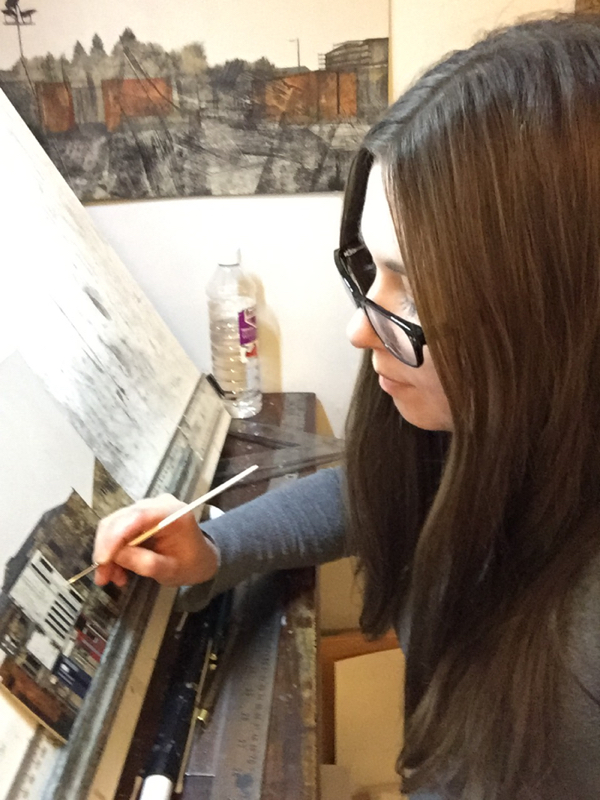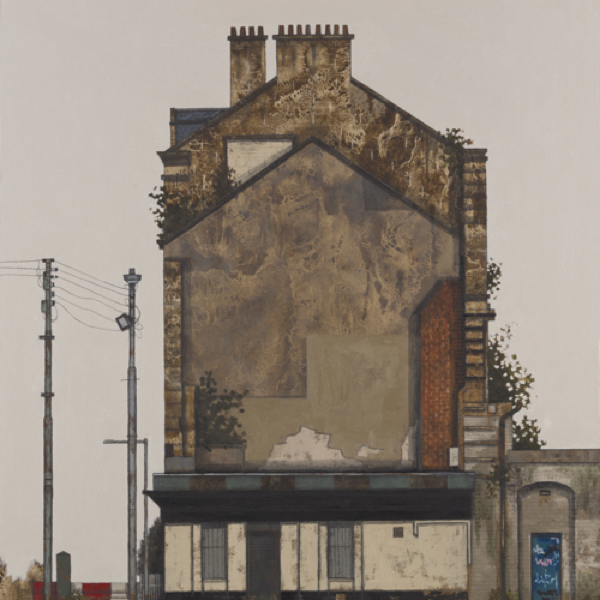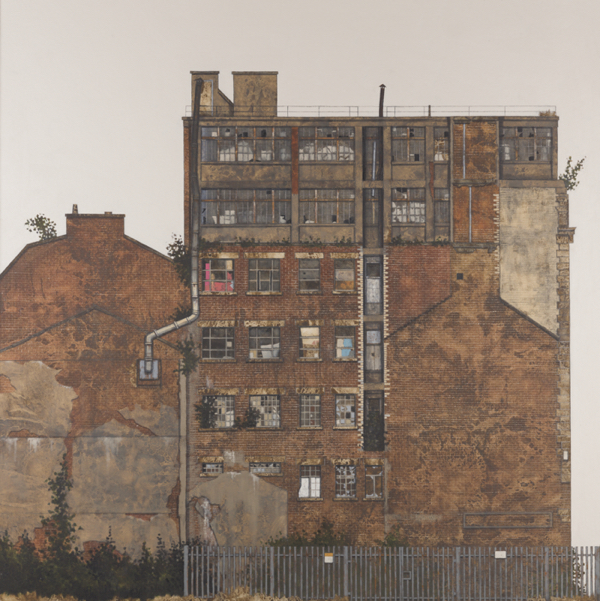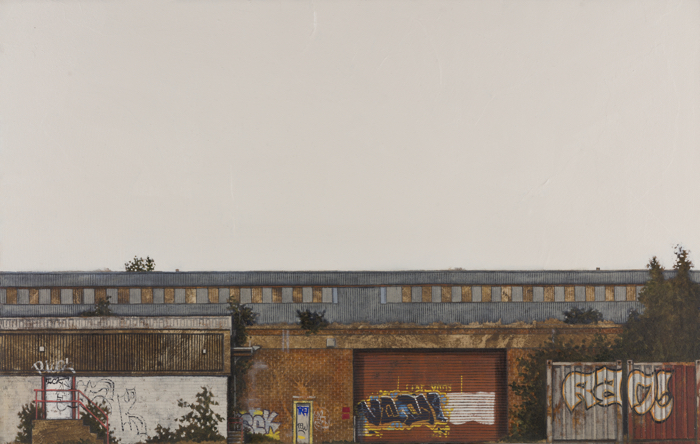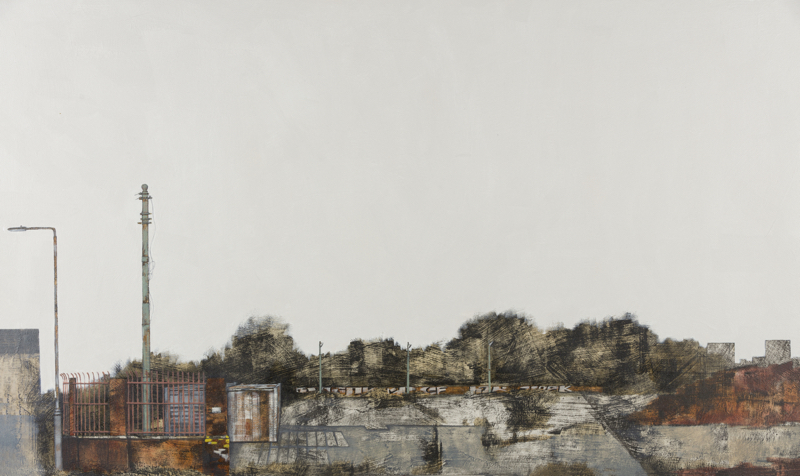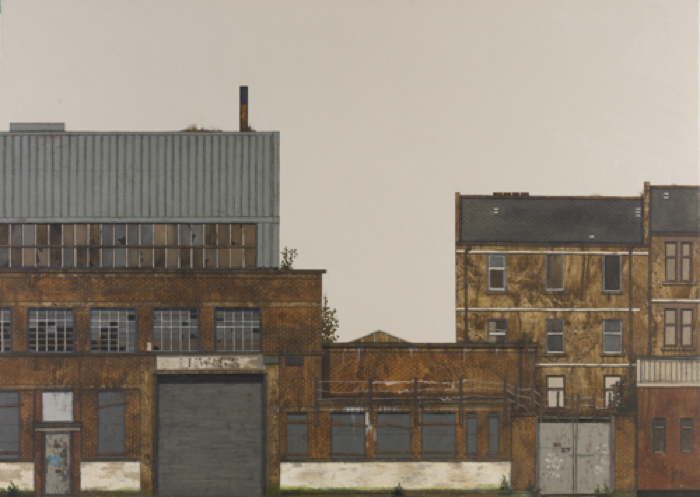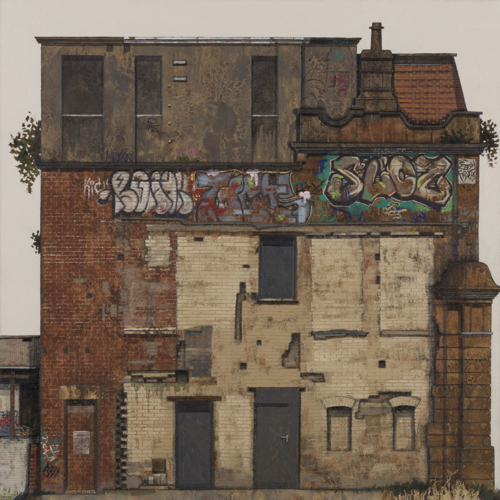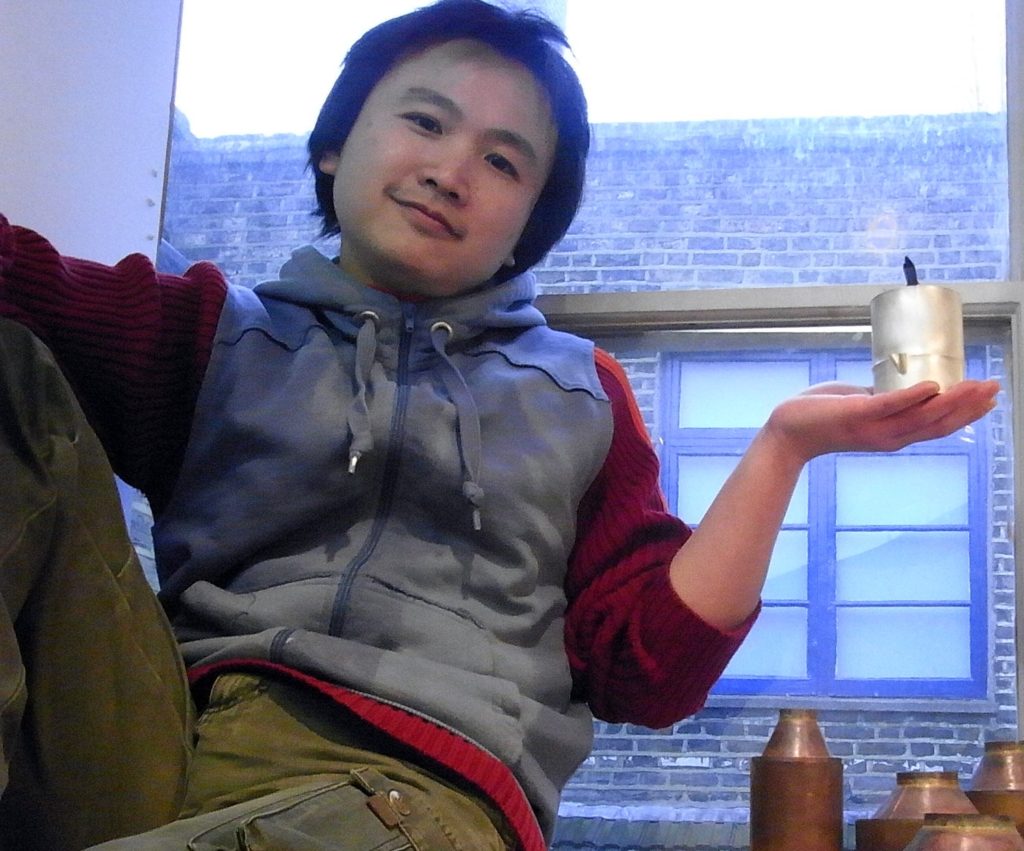Cate Inglis
What draws you to paint urban landscapes?
I have always had a fascination with architecture. The earliest memories I have are from when I lived in the Greenock area on the Clyde. The industrial nature of that place in the 70’s, with its cranes and shipyards, grand merchant buildings and the awesome, brick-built sugar sheds, made a lasting impression on me.
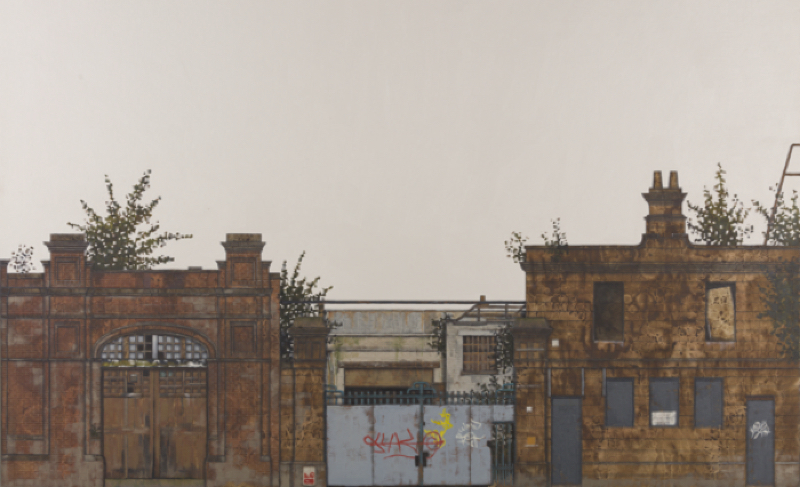
Entrances
Now living further up the Clyde in Glasgow, and witnessing the decline of these industrial spaces and structures, I am drawn to urban and post-industrial areas to document the disappearing and ever-changing landscape of these environments. As the architecture is overtaken by processes of nature and neglect, I am fascinated by the combinations of textures and colours in these urban environments - the peeling paint, rusting metal, greening concrete and decorative brickwork. Increasingly, I am drawn to heavily graffitied surfaces and enjoy the colour they bring to my often muted palette.
Deconstruct
You comment, “A key part of my process involves going on-site, to places I perhaps shouldn’t” discuss.
A lot of the places I do my urban exploration (urbexing) are often fenced off or boarded up as the buildings are derelict and deemed unsafe. So I say that I ‘perhaps shouldn’t' because there is an element of risk at these sites and the public are not really permitted to access them. However, because it is the exterior of the these buildings that I am interested in, I take less of a risk than some of my fellow urbexers who venture inside.
Bridge Structure
Do you see your work as a historical reorder?
Although the majority of buildings I paint are historical, I see my work as capturing them in the present; as they are at the moment in time I discover them. I am unsentimental in the way that I portray the structures. My paintings are an honest representation of the reality I see in front of me. The buildings tell their own story.
Explain about the small details in your paintings.
Small details are intrinsic to my work. Every brick, every loose tile, every broken window and rusty drainpipe is painted in meticulous detail, because these are the elements that describe the age and deterioration of the building. I continue to develop techniques to render these effects on the different building materials. I have a lot of patience and am a
slave to accuracy, and find this painstaking work very enjoyable. How has lockdown affected your ability to visit sites to paint? Lockdown has had a huge impact on the way I have been able to work this last year. Due to an underlying health condition, I have been shielding for the most part and unable to leave my house. My creative solution was to turn to Google Street View to explore locations I had intended visiting. I had used it in the past as an additional resource, and although not as ideal as actually being there in person, and restrictive interms of the angles I could see, it was a good substitute in the circumstances. My latest Solo Exhibition was the culmination of this different way of working, created while juggling periods of homeschooling my young daughter.
Over Crowded
Explain on your award and membership of the Society of Scottish Artists in 2016.
In 2016 I was awarded Professional Membership of this highly respected arts body which was founded in 1891. It has a long history of championing contemporary Scottish art and its main exhibiting space is in the beautiful Royal Scottish Academy in Edinburgh. To gain Professional Membership you must be actively practicing in the visual arts. A body of work is peer-reviewed by other Professional Members of the Society and is only awarded to those that demonstrate talent and dedication in their chosen field. I was honoured to receive this endorsement of my practice and continue to show my work in their Annual Exhibition at the Academy where I have won several awards.
Department
How do you start the process, by photography or sketch book work?
Photography is my primary method of resource gathering. I have a particular way of photographing buildings to capture every detail, taking a series of shots of the elevations, then finding vantage points to photograph the roof and architectural features that can’t be seen from ground level. Each painting is drawn from a series of photographs of one side of the building. The preliminary sketches I do prior to draughting a painting are mainly to work out composition. The nature of finding my subjects in ‘out of bounds’ locations means that I don't hang around long enough to get caught, so on-site sketching isn't really a practical option.
Railway Sheds
Can you tell us how you decide on the angle you will paint either a building or group of buildings?
I think that one of the things that makes my work distinctive is that I paint my subjects like an architectural drawing. There is rarely any perspective in my work, instead I paint the elevations of the buildings in the same manner that the architect would draw the plans. I transpose the information I collect in my photographs into a perspectiveless view of
the entire side of the building, with everything at eye-level, and use shadows to describe the 3-Dimensional form.
Levelled Terminus 11, Monotype Series
Has there been a site that could almost be a series in itself?
Most sites I visit yield several paintings if they have good access. I often paint all the different sides of buildings individually creating a series of related paintings. I have several favourite locations that I return to time and again, to document how they have changed since my last visit. These include a group of derelict Victorian and 60’s railway sheds and
the area around the disused Graving Docks on the Clyde. There are also some fantastic locations in more built up areas of the city where I have done a lot of paintings of a group of buildings from each different side.
Clydeside
Discuss the sizes of your work and how you choose the size?
My work has been getting larger of late. I have been working on bigger supports than I have in the past, mainly because of the subject matter I am choosing and the level of detail within them. The sizes and shapes of each piece is dictated by the subject matter itself to some extent. Sometimes I like big skies and a further away viewpoint to give a sense of the emptiness of a location, and for others I choose to be very close up with very little space around the building to give the feeling of
crowded urban areas with buildings packed together, blocking out the sky.
Cross Section
Expand on the impact the horizon line has in your work.
As I described previously, unusually I don’t tend to use a horizon line in my work, preferring not to use perspective, but to treat each subject like an architectural drawing.
However, a few years ago I did create a body of monotype based work focussed around industrial wastegrounds - the places where buildings once were but had been demolished. This different subject matter required that I use perspective to describe the vast emptiness of the spaces, with the remaining disparate buildings that occupied the
perimeters of these sites. The low horizon line I employed for these works gave the feeling of an empty, bleak space - a place that once was a hive of industry, reduced to a concrete footprint with weeds coming through the cracks. It was an interesting exercise to play around with different viewpoints and change up my subject matter.
Feature Wall
Contact:
Cate Inglis
www.cateinglis.com
cateingliscom@gmail.com
Deborah Blakeley, Melbourne, Australia
Interview by Deborah Blakeley, August 2021
Chien Wei Chang
You have been in the UK since 2000, what lead you to take this leap from Taiwan to UK?
I used to work in Tiffany & Co. Taiwan for nearly 4 years, 3 years in retail and one year in cooperation department. At the age of 29, I decided to quit my office job and go overseas to learn contemporary jewellery design. In the beginning, I applied to jewellery colleges in Germany, USA and England. The London Guildhall University contacted me first and offered me a place. Without any hesitation and knowledge about what the modern British society was like, I have booked my flight straight away and started my journey of living in Britain.

You comment on your relationship with silver, ‘I still love it as it was my original passion’ discuss.
I love silver’s characteristics and the process of making it work: treating it with fire to anneal it, using hammers to translate the invisible ideas into visual forms, and bathing it in water to cleanse it. When I place silver into acid to purify and turn it white, it feels as though I have completed a personal ritual – almost like a baptism.
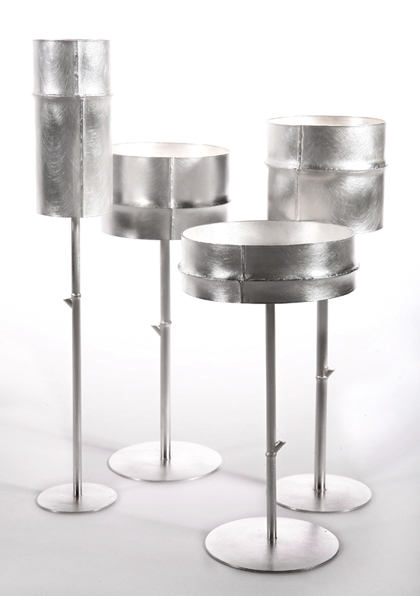 Bamboo Goblets
Bamboo Goblets
But after years working with silver, I have been trying very hard to break its traditional bond of serving as a material for function and the stereotypical image of its commercial value as a precious metal. Therefore, recent years I have also used different metals in my works to enhance the contrast with silver and combined metals (including silver) with various materials, such as found objects, glass, ceramics, resin, wood, etc. to enrich the visual vocabulary.

Smoking Bottles
However, I still see ‘silver’ as my favourite metal.
What other metals do you use?
Copper, brass, gold, steel, rusty nails, broken metal parts of tools/machines.
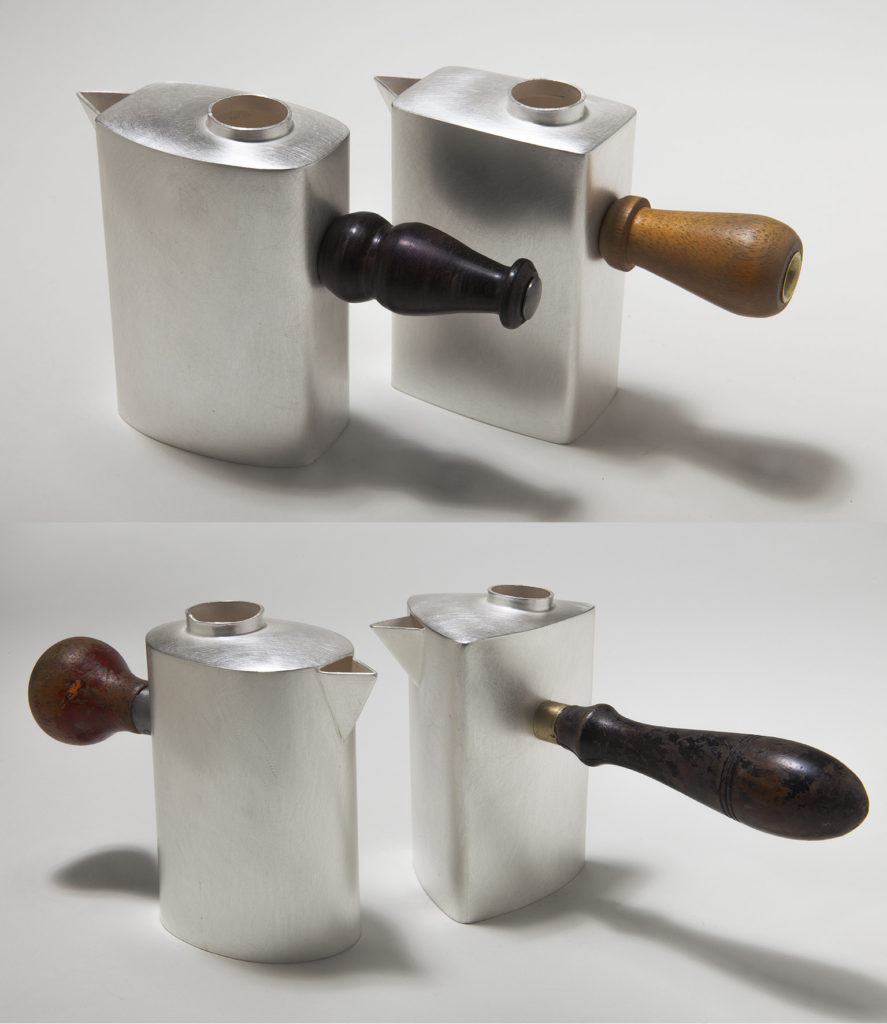
Handle Me I
With these new metals in your studio tell us about one that is new to you and why you have introducing it into your work?
There are some broken parts (metals) of machines or tools which I found in car boot sales. Usually I will display or hang them in certain arears in my studio so that I can see them from time to time. I like them because of the historical and nostalgic elements of found objects.

Cheese and Cake
With the indication of time (when they were produced or made) and place (where and who might have produced them), you can start an imaginary journey to trace back the habits, family background and domestic environment of owners. Definitely there are stories you can dig in.
Expand on the handles you use in your work.
I like to use metals to create vessel forms with handles, like extensions from the main bodies. Usually the handles will be different materials, such as a piece of off-cut wood
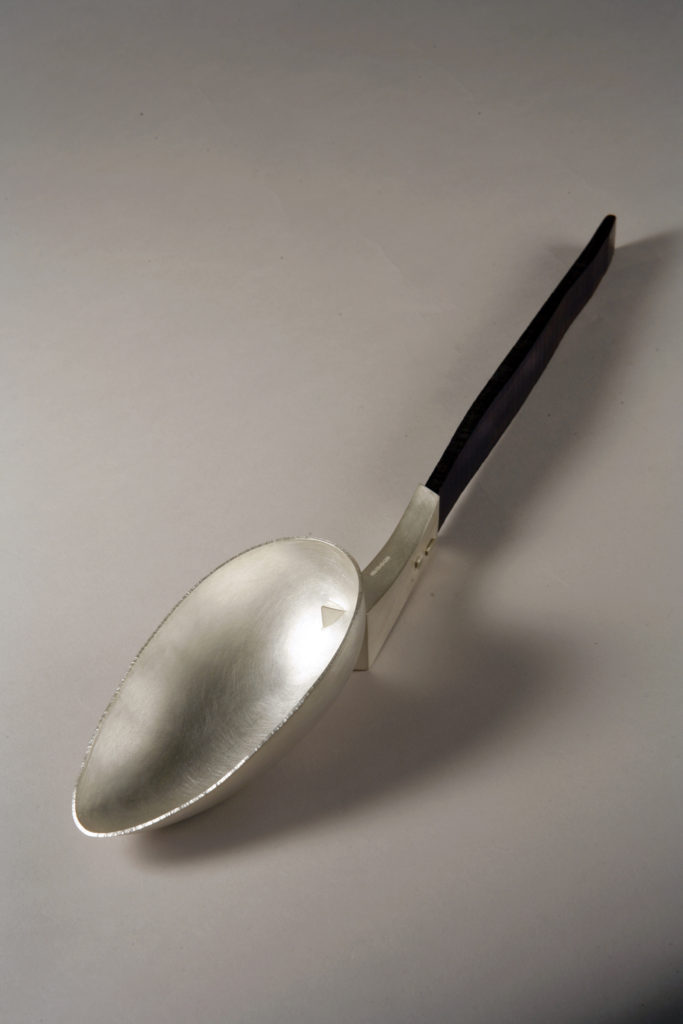 Irresistible Seduction of Downfall
Irresistible Seduction of Downfall
or a found ceramic shard.

‘Ashore’
I enjoy in the process of experimenting the different positions of the vessel form and the extension part. The way of how they are jointed together decides the relationship and interaction between them. I always try to add the dramatic element in my work in a poetic style.
Your work has developed and grown in demand. How and when do your put on an assistant?
How do you control the integrity of your work?
Honestly, I am a control freak when it comes to the creation of my work. I used to produce batch works as my bread and butter to make ends meet in my early career. Now, I am producing one-off pieces for the collectable market. Besides, one important feature of my work is the meticulous details. I love to experiment the various possibilities in the making process so that the outcome always is a surprise.
 My Broken Spoon
My Broken Spoon
With this kind of approach and attitude, it’s difficult to achieve with other people’s hands. However, there are some limitations of my own ability in terms of techniques and studio equipment, such as steel welding and cutting machine for large scale pieces. Therefore, some parts of my works will be produced by outworkers before the detailed discussion with professional technicians.
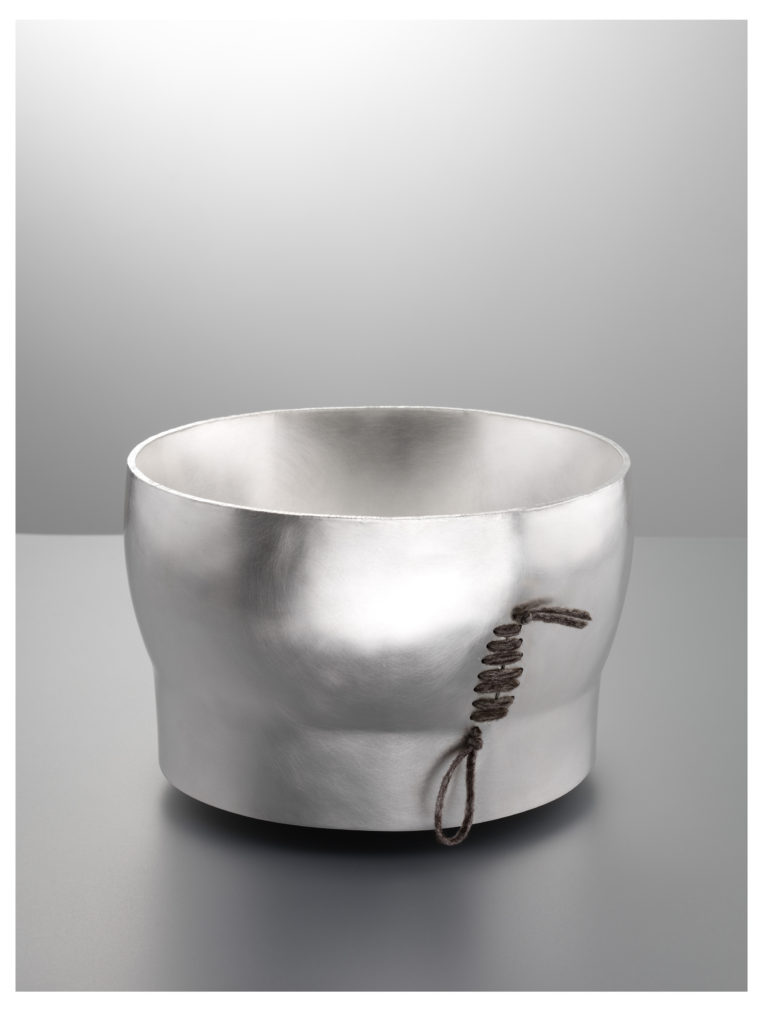 Wounded Souls in Healing Process
Wounded Souls in Healing Process
Discuss your work in relations the blending of East (your past) and West (your future).
I always believe that only the great art works with genuine honesty will really touch peoples’ hearts and move us. As for me, I always use my works to honestly reflect my own true experience in life. Therefore, the process of blending of East and West comes naturally, not intentionally.
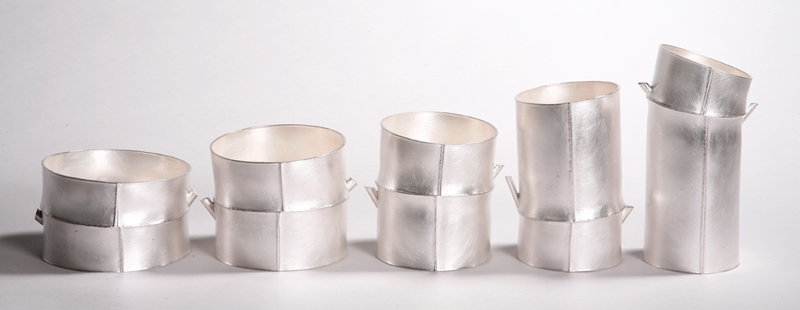
Bamboo Containers
As I stated in my writing, ‘Each piece I produce has a title and depicts different stage of the narrative of my life’. Since I already started my own journey from East to West years ago, the change is not only about physical and geographical, but also about the cultural, social even political. The reflection of how much East or West is just about the issue of time, when and where I am now and how long I will stay.
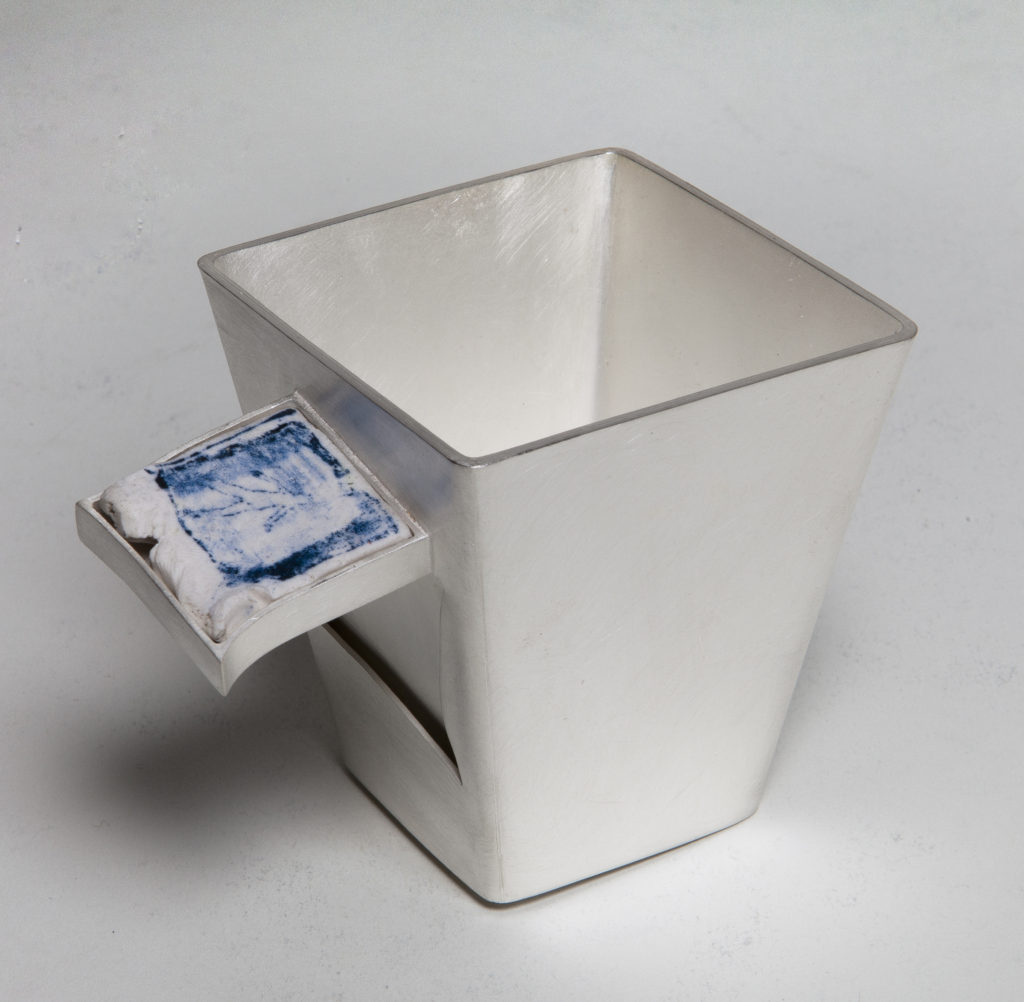
Key Stones - 1
How has your work altered from functional to the applied arts?
After several years working in the collectables market of British contemporary crafts, I began to establish myself as a metal artist working in the field of European applied arts. However, it began to strike me that the stereotypical image of craft held by the general public is still that of the functional, decorative, craft-made object, which although beautiful lacks a real sense of social context.

Perfectly Matched
I want to challenge this perception and try to prove that craft can step out of its domestic environment to engage with a wider public audience. That’s why during recent years I have started to combine/use various materials to produce large-scale sculptures or installation exhibitions in the public space.
Discuss the wonderful images especially of you and your huge ladles?
There is a common misunderstanding about this image. The model in this image is not me and this image is not done by Photoshop. The initial intention of this image is to show the actual scale of this ladle.
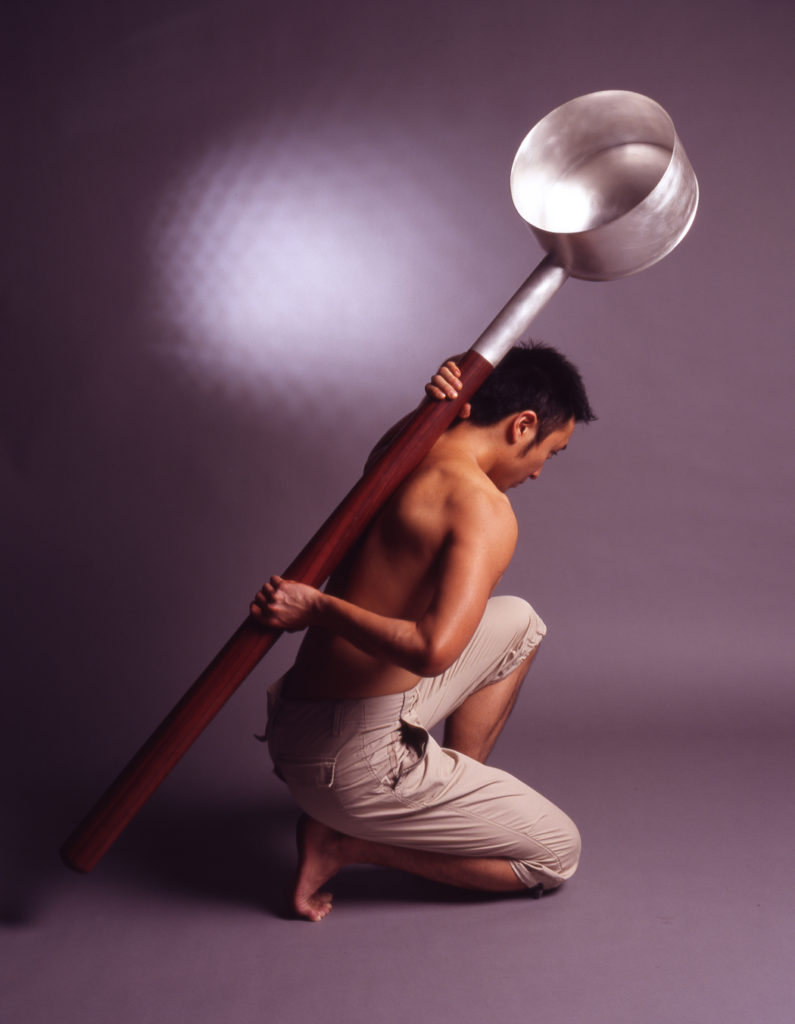
Huge Ladle, Photograph by Steven Brayane
When we were doing this photo shooting in studio, what I wanted to achieve was the theatrical effect of showing the battle between me and this ladle while I was making it. Therefore, I hired a male model and tried so many different positions of how he was handling this ladle. With several trials and long discussion with my photographer, Steven Brayane, we all agreed that this ladle was carried on his back really dramatised the conflict between the human body and this sculpture. As a result, this was a very successful image and people started to know me because of it. This image was on the cover of UK Crafts Magazine, September 2006 issue.
Expand on your comment, ‘Each piece I produce has a title and depicts different stage of the narrative of my life’.
A eulogy for my broken spoon

In my memory, I hardly can trace back to the very first encounter with this spoon.
Was it at a charity shop?
Or in a local car boot sale?
How could I remember…
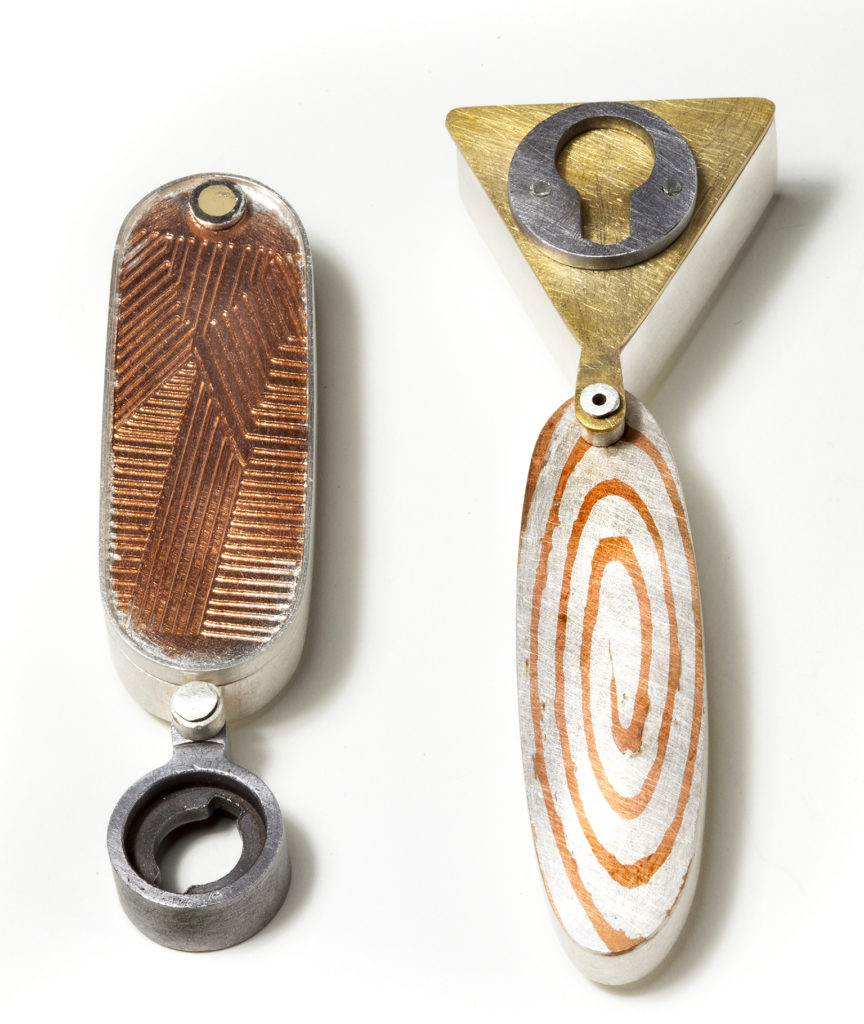
Missing Buttons
It is a common experience that someday we find buttons missing from a favourite item of clothing, but you found it was quite hard to find an identical replacement. This is especially true if the button is a bit unusual, and one that is not mass produced by fashion industry. Generally speaking, the design of buttons has a decisive effect on the appearance of clothes and becomes a key element of the new trend of fashion design.
The great irony in life is that we usually do not realise how valuable and irreplaceable it is, until we have finally lost it. No matter how hard we try to find something or someone to replace it, it is never the same!
To me, life is a story about those missing buttons.
Contact details:
Chien Wei Chang
Chien Wei Chang, Bournemouth, UK
Interview by Deborah Blakeley, December 2018

